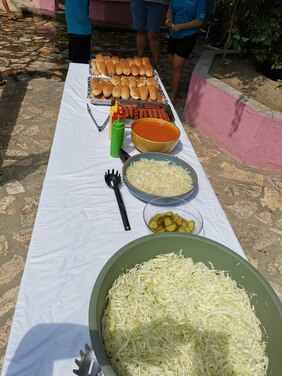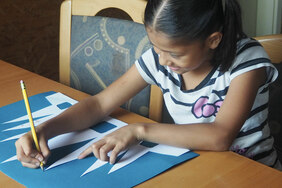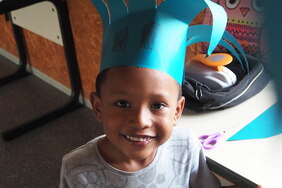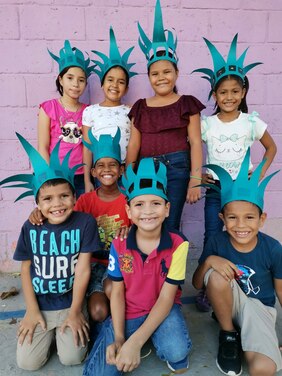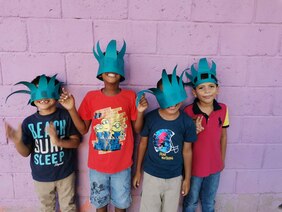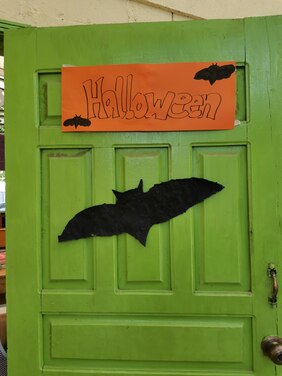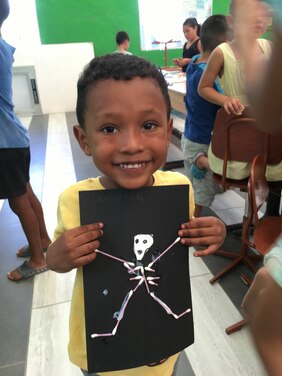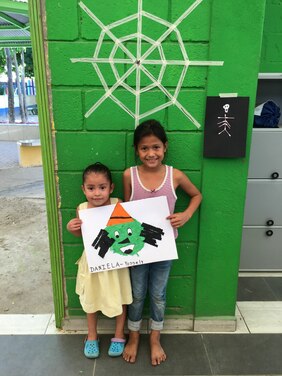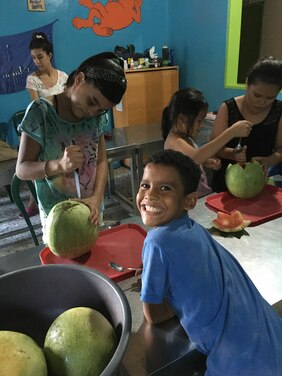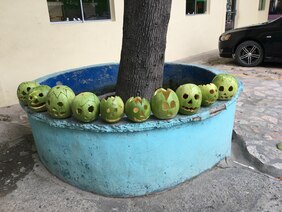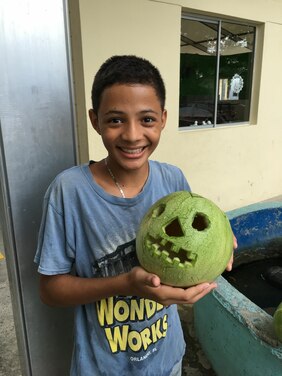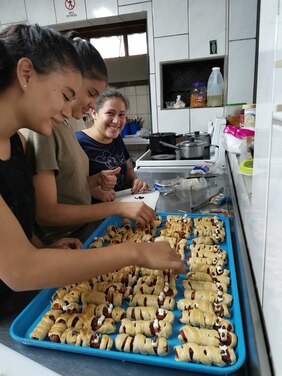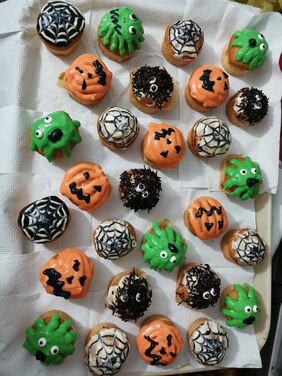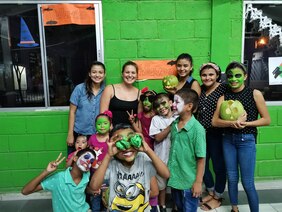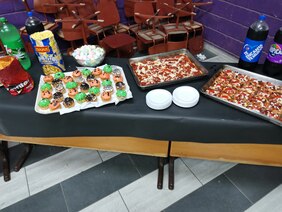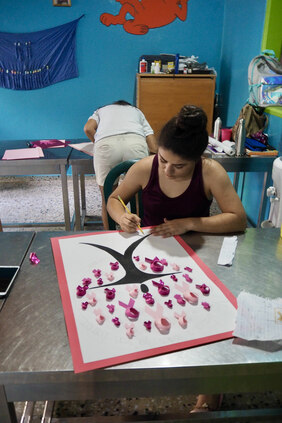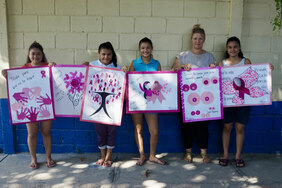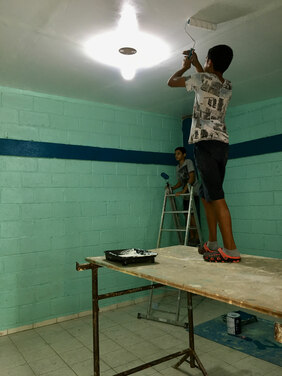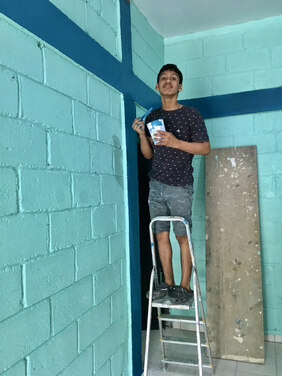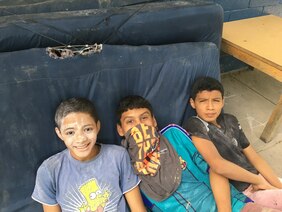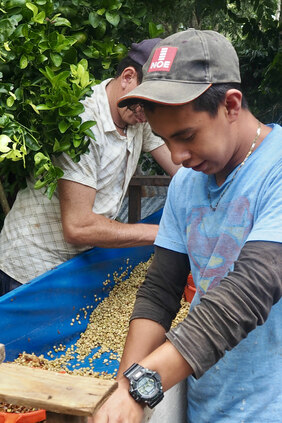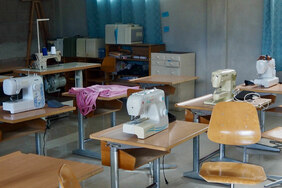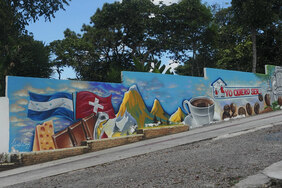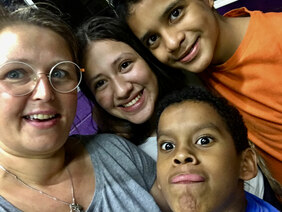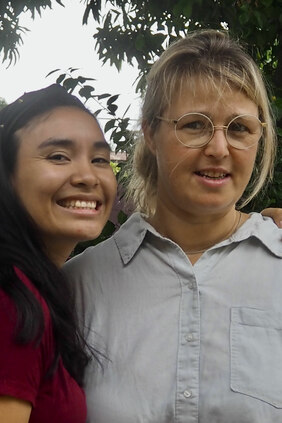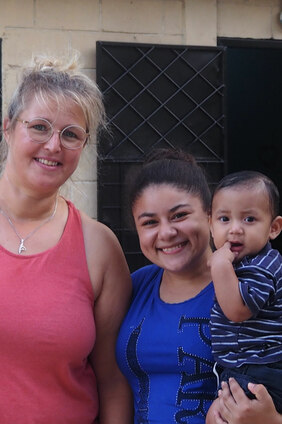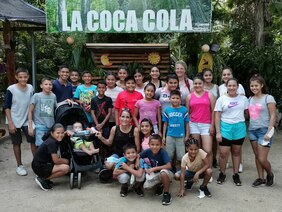The beginning of my journey to the children’s home was a little bit rough due to Covid travel restrictions. Therefore, I was more than happy as Patricia came to get me at the airport of San Pedro Sula. While we were driving to the children’s home, I barely noticed the small colorful houses around me with painting peeling off, the corrugated sheet roofs, the windows covered with grate, the high barbed wired walls and the very dirty roads. Just a few days later while driving through the neighborhood I started to become aware of my surrounding. Patricia, affectionately called Paty by everyone, stopped by a big black entrance gate and honked two times. A friendly looking, middle-aged man opened the gate: his name is Miguel. He is the guardian, opens and closes the gate and makes fun with the kids. He was the first employee I got to know.
Paty proudly showed me the home for about 40 girls and boys. All the rooms and places are nicely painted in green, purple, turquoise, yellow and give a very welcoming and pleasant impression. She then explained me all the local specialties and some first kids came around and gave me a nice welcoming smile or hug. The children’s home has on one part the bedrooms for the girls and boys and additional to that a Kindergarten which is called “sala cuna”. This is where the smallest kids and two kids with special needs are living, playing, laughing and dreaming.
My Spanish skills are very limited wherefore I am using a translation application on my phone and mostly my hands and feet to communicate. But the children took it very easily and were supportive. It was beautiful to see that they were curious and wanted to get to know me. So it became quite normal that kids ran towards me, touched me and hugged me all the time.
«Soccer» and «futbol» are two words I understood straight ahead. So I started playing with them in the incredible heat (called “calor” here) which literally is all over the places here. As I used to play soccer in my younger days and got motivated by the skills and tricks the kids displayed, I got back my fascination for that sport. I was especially impressed by their team spirit and their happiness for each goal. And I love to see how football can bring people together regardless of language barriers or other differences.
Paty, which kindly is called “mama” around the kids knows all of her “niños” with their background stories and their destinies. She hearty welcomes all of them, shows compassion and warmth and leads them through their current situations. She told me about Andres, the youngest kid here at the moment, about Daniela and Ana. The way she was talking about them I felt her huge heart and her solidarity. She was talking about violence, corruption, abuse and death, which all are present in Honduras’ everyday life. People are living day by day. Nevertheless, she hasn’t lost her faith in the good in human beings. She told me about the guardian angels which are watching over the children’s home, what brought a nice easing over me for the length of my stay.
Apart from the children’s home the foundation has other social projects to support the people in need. One afternoon some of the teenaged kids were packaging detergents, soap, rice, corn, flour and plenty of other goods to cover the basic needs. These donations were then distributed to the poor and those in need. Moreover, Paty one day was counting a big amount of drugs and medicine. She explained to me that the foundation is monthly providing an institution with children with special needs with the urgently needed medication.
Fabienne, another volunteer from Switzerland, who has been here many times before and fluently speaks Spanish, helped me planning different events and activities for the kids. Paty announced a group from the U.S. coming over to spend four days in the children’s home. So we started teaching the children basic conversation in English: “What’s your name? Where do you come from? What do you like?”. The kids learned quickly and were highly motivated. The smaller ones created a “ME-book” where they draw themselves, their homes, their favorite colors and then learned to answer simple questions in English. Unfortunately, the visit was canceled and the learned content couldn’t be brought into practice. But still the kids stayed motivated and therefore we decided to plan an “Ami-Day” (American day). The goal of the day was to learn some facts about the U.S. and to record a video to send to the donators in the U.S. The children learned some facts about the statue of liberty and had to wrote them down in English. The elder ones then had to practice their introduction conversations in role plays and the smaller ones created the crown of the liberty statue to put on their heads and drew some U.S.A. flags. For lunch we prepared a typical American meal: Hot Dogs and Coca Cola – the kids loved it!
After lunch everyone made themselves pretty and neat to record the video on the sports court. The smaller ones danced “old Mc Donald has a farm…” and the elder ones showed their roleplay. We noticed that everyone was excited but a bit nervous too. After successfully recorded the video everyone got ice cream “Ami-style”: colorful crumbles, toppings such as different sauces and marshmallows. Later on, we watched the movie and all were happy but some kind of tired from the eventful day.
Since the beginning of the Corona-pandemic in March 2020 all schools in Honduras have been closed and no face-to-face teaching has taken place. This means that since almost two years the pupils are facing home schooling which comes in very different ways: the kids of the primary electronically get their homework every morning and have to send them back every evening. The elder pupils attend classes via Zoom and send in their works online. In the children’s home two teachers, a psychologist Raquel, Karen and the young women support the kids in their tasks but nevertheless “distance learning” has left its marks. But in which areas do they need further support? Together with Fabienne we decided to make an evaluation of their level of knowledge and therefore used the official school tests which are used to class new pupils at the beginning of a school year.
I got some support to test the kids in 1st and 2nd grade by Yesi, who is currently studying Psychology. She translated my instructions and forwarded the kids’ questions to me so I was able to understand them. To do the testing of the elder pupils I helped myself with my translation app which was a bit demanding for them as they had to be very patient and comprehensive. Once we evaluated all the tests, we’ve seen that especially the youngest ones lack a solid basis and that they struggle with even simple tasks. But we were now able to plan the four months of long official holidays which were about to start at the end of October. This is where I really could bring in my knowledge and skills from my background as a special education teacher (“Schulische Heilpädagogin”). I collected plenty of materials such as exercise sheets for basic education, Youtube-Videos, different games for math and general ideas to do handicrafts and to learn in a playful way. Fabienne then traduced the materials and together with Paty they implemented it and introduced it to the teachers and the psychologist.
One early Thursday morning Alfredo, the chauffeur, took me on a trip to Santa Rosa de Copán. I was a bit nervous due to the upcoming unknown and the language barrier. But we somehow managed to communicate with facial expressions and gestures. We drove along roads with huge holes in it, many construction sites full of men with shovels in one and bottles in the other hand to somehow stand the scalding heat. The ride was like a slalom race and Alfredo just laughed as he saw my stunning face. Along the roads we’ve seen plenty of coffee plantations, banana trees and further into the hills we drove. We quickly stopped by a lookout and had a breathtaking view down into the valley. After about four hours we got to the education center in Santa Rosa de Copán. Friendly we were welcomed by José Luis, the director of the center. He proudly explained me everything about the coffee plants, the mango- and lemon trees and the beautiful view into the valley in a perfectly fluent English. Two young men were peeling coffee beans and José Luis told me to try one: it was some kind of sweet and didn’t have any coffee taste as I would have expected it.
We then walked through the beautiful and big classrooms of the building. Three courses took place that day: English and Computer for teachers as well as practical lessons for nurses. The director then showed me the remaining rooms where first aid courses, painting courses and suing courses take place. He told me about a workshop where they learn how to sew and process leather which is a profession that is at risk to disappear. But Covid left its marks here as well: many courses had to be cancelled or postponed. I really hope that those courses for young adults can take place normally as soon as possible.
After the «Ami Day» together with Fabienne we planned a Halloween-Party. We decorated the big salon with ghosts made out of Lollipops, skeletons, bats and pumpkins. Instead of carving pumpkins we used watermelons, we decorated some scary looking muffins and plenty of other things. In the late afternoon all kids’ faces were colored in different characters and we then opened the big buffet: Spider net-Pizza, popcorn, chips and a big variety of sweets. All the kids were actively engaged, highly motivated and seemed to really enjoy the day.
After all these activities I lend a hand in some do-it-yourself and constructions works in the buildings and surroundings of the children’s home. Together with Alfredeo, Amilkar, Fabienne and the elder boys we renewed a ceiling with plaster boards which sometimes was quite tricky and requested creative solutions. Together we did it and hat a lot of fun. Once finished we then painted the two rooms inside. I was quite amused as my translation app gave me the word “sky” for the ceiling – as if it knew we painted it in “azul” blue. I was fascinated by seeing how much effort and energy the boys put in their work and the final result is really beautiful and welcoming.
Fort the 28th of October, the Pink Ribbon Day, we were asked to create some posters according the topic. So I engaged myself into the work together with five young women. Out of pink and rosé paper and cardboard, glitter and ribbons we created beautiful placards and had a good time together.
As a special education teacher (“Schulische Heilpädagogin”) I was highly pleased about the offer to see the school for children with special needs, which is visited by three of the children. But since March 2020 no contact teaching has taken place and distance learning isn’t appropriate in this specific situation. Still the teachers are in the schools and were happy to get some entertainment in receiving us as visitors. Compared to Switzerland the rooms are quite small and one teacher is in charge for approximately 20 children. In primary and secondary school the amount of pupils per teacher is at about 40. I do ask myself how those teachers would be able to give the children the attention they really need to promote their abilities and personalities. But in general I noticed that people with special needs seem to be people without any rights here in Honduras. Their opinion and point of view is barely recognized by the public. Therefore it was so beautiful to see that this is lived in a different way inside the walls of the children’s home.
My time here now comes to an end. I am so grateful for all the beautiful encounters, the enriching discussions – with or without translation application – the valuable experiences and the loads of hugs I experienced.
“Muchas gracias” and I look very forward to see you all again very soon!
Annett
